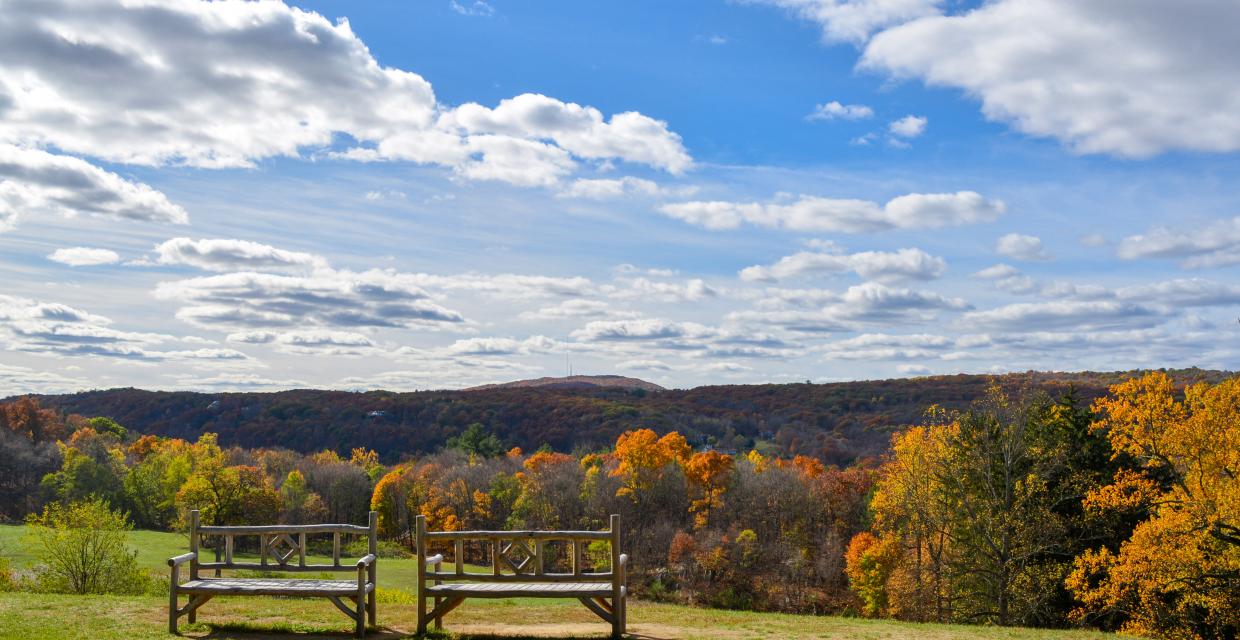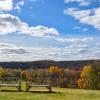Hyde Park Trails




Park Overview:
The Hyde Park Trails system links three National Historic Sites – notably FDR’s estate, Eleanor Roosevelt’s “Val-Kill” and Vanderbilt Mansion – together with trails in a cluster nearby parks under the banner of “Walkabout Trails.”
Park Description:
The Home of Franklin D. Roosevelt National Historic Site contains his house, library, rose garden, grave and a small museum. Val-Kill is the former cottage of Eleanor Roosevelt and houses her effects and memorabilia. The Vanderbilt Mansion contains a vast collection of antique furnishings and is surrounded by a landscape that includes magnificent views of the Hudson River and a formal Italian garden. Fees are charged to tour the buildings, but access to the grounds and trails are free.
The “Hyde Park Walkabout” project aims to promote healthy physical activity by encouraging walking/hiking on designated trails in the surrounding area (see Web Map link above)
- The Hyde Park Trails system is a cooperative effort of the Town of Hyde Park, National Park Service, Scenic Hudson Land Trust Inc., Winnakee Land Trust, and several private landowners.
Trails Overview:
The Vanderbilt Mansion and FDR National Historic Sites border the Hudson River. The NPS Hyde Park Trail (10.4 miles) through and between them travels from waters edge at one point, near Vanderbilt Mansion, to the bordering ridge before heading inland, via Scenic Hudson Land Trust property, to the Val-Kill site. Around the mansions, the trail meanders through beautifully tailored grounds. In other parts of the estates, the trail passes large specimen trees, small swampy areas, streams, rock outcrops and wooded areas. The trail is marked with green tulip tree leaf markers.
The Hyde Park Walkabout Trails map displays 11 trails (23 miles) in 9 parklands including the national historic sites and Mills-Norrie State Park along the Hudson River. Map inserts for each trail include a brief description, mileage (ranging from 0.7 to 3.6 miles), parking and trailhead location.
Park Acreage:
Not availableMunicipality:
Hyde ParkThe Hyde Park Trails system links three National Historic Sites – notably FDR’s estate, Eleanor Roosevelt’s “Val-Kill” and Vanderbilt Mansion – together with trails in a cluster nearby parks under the banner of “Walkabout Trails.”
The Home of Franklin D. Roosevelt National Historic Site contains his house, library, rose garden, grave and a small museum. Val-Kill is the former cottage of Eleanor Roosevelt and houses her effects and memorabilia. The...
Park Acreage:
Not availableMunicipality:
Hyde ParkContact Information
Web Link:
Hyde Park Trail –Town of Hyde Park Recreation DepartmentPhone:
Not availableFees:
Some times and places; check with parkDogs in park:
Dogs on leashHike Checklist:
Whether you are going for a day hike or backpacking overnight, it is good practice to carry what we call The Hiking Essentials. These essentials will help you enjoy your outing more and will provide basic safety gear if needed. There may also be more essentials, depending on the season and your needs.
The Essentials
Hiking Shoes or Boots
Water - Two quarts per person is recommended in every season. Keep in mind that fluid loss is heightened in winter as well as summer. Don't put yourself in the position of having to end your hike early because you have run out of water.
Map - Know where you are and where you are going. Many of our hiking areas feature interconnecting network of trails. Use a waterproof/tear-resistant Tyvek Trail Conference map if available or enclose your map in a Ziplock plastic bag. If you have a mobile device, download Avenza’s free PDF Maps app and grab some GPS-enhanced Trail Conference maps (a backup Tyvek or paper version of the map is good to have just in case your batteries die or you don't have service). Check out some map-reading basics here.
Food - Snacks/lunch will keep you going as you burn energy walking or climbing. Nuts, seeds, and chocolate are favorites on the trail.
Sunscreen and insect repellent
Rain Gear and Extra Clothing - Rain happens. So does cold. Be prepared for changing weather. Avoid cotton--it traps water against your skin and is slow to dry. If you are wearing wet cotton and must return to your starting point, you risk getting chills that may lead to a dangerous hypothermia. Choose synthetic shirts, sweaters and/or vests and dress in layers for easy on and off.
Compass - A simple compass is all you need to orient you and your map to magnetic north.
Light - A flashlight or small, lightweight headlamp will be welcome gear if you find yourself still on the trail when darkness falls. Check the batteries before you start out and have extras in your pack.
First Aid Kit - Keep it simple, compact, and weatherproof. Know how to use the basic components.
Firestarter and Matches - In an emergency, you may need to keep yourself or someone else warm until help arrives. A firestarter (this could be as simple as leftover birthday candles that are kept inside a waterproof container) and matches (again, make sure to keep them in a waterproof container) could save a life.
Knife or Multi-tool - You may need to cut a piece of moleskin to put over a blister, repair a piece of broken equipment, or solve some other unexpected problem.
Emergency Numbers - Know the emergency numbers for the area you're going to and realize that in many locations--especially mountainous ones, your phone will not get reception.
Common Sense - Pay attention to your environment, your energy, and the condition of your companions. Has the weather turned rainy? Is daylight fading? Did you drink all your water? Did your companion fail to bring rain gear? Are you getting tired? Keep in mind that until you turn around you are (typically) only half-way to completing your hike--you must still get back to where you started from! (Exceptions are loop hikes.)
Check the weather forecast before you head out. Know the rules and regulations of the area.
The Leave No Trace Seven Principles
Plan Ahead and Prepare
- Know the regulations and special concerns for the area you'll visit.
- Prepare for extreme weather, hazards, and emergencies.
- Schedule your trip to avoid times of high use.
- Visit in small groups when possible. Consider splitting larger groups into smaller groups.
- Repackage food to minimize waste.
- Use a map and compass to eliminate the use of marking paint, rock cairns or flagging.
Travel and Camp on Durable Surfaces
- Durable surfaces include established trails and campsites, rock, gravel, dry grasses or snow.
- Protect riparian areas by camping at least 200 feet from lakes and streams.
- Good campsites are found, not made. Altering a site is not necessary.
- In popular areas:
- Concentrate use on existing trails and campsites.
- Walk single file in the middle of the trail, even when wet or muddy.
- Keep campsites small. Focus activity in areas where vegetation is absent.
- In pristine areas:
- Disperse use to prevent the creation of campsites and trails.
- Avoid places where impacts are just beginning.
- Pack it in, pack it out. Inspect your campsite and rest areas for trash or spilled foods. Pack out all trash, leftover food and litter.
- Deposit solid human waste in catholes dug 6 to 8 inches deep, at least 200 feet from water, camp and trails. Cover and disguise the cathole when finished.
- Pack out toilet paper and hygiene products.
- To wash yourself or your dishes, carry water 200 feet away from streams or lakes and use small amounts of biodegradable soap. Scatter strained dishwater.
- Preserve the past: examine, but do not touch cultural or historic structures and artifacts.
- Leave rocks, plants and other natural objects as you find them.
- Avoid introducing or transporting non-native species.
- Do not build structures, furniture, or dig trenches.
- Campfires can cause lasting impacts to the backcountry. Use a lightweight stove for cooking and enjoy a candle lantern for light.
- Where fires are permitted, use established fire rings, fire pans, or mound fires.
- Keep fires small. Only use sticks from the ground that can be broken by hand.
- Burn all wood and coals to ash, put out campfires completely, then scatter cool ashes.
- Observe wildlife from a distance. Do not follow or approach them.
- Never feed animals. Feeding wildlife damages their health, alters natural behaviors, and exposes them to predators and other dangers.
- Protect wildlife and your food by storing rations and trash securely.
- Control pets at all times, or leave them at home.
- Avoid wildlife during sensitive times: mating, nesting, raising young, or winter.
Be Considerate of Other Visitors
- Respect other visitors and protect the quality of their experience.
- Be courteous. Yield to other users on the trail.
- Step to the downhill side of the trail when encountering pack stock.
- Take breaks and camp away from trails and other visitors.
- Let nature's sounds prevail. Avoid loud voices and noises.
The Trail Conference is a 2015 Leave No Trace partner.
(c) Leave No Trace Center for Outdoor Ethics: www.LNT.org.



The Hyde Park trail, is the underrated highlight of Hyde Park. It is not given half the love it deserves, and most people don't even know it exists.
The Hyde Park Trail is over 20 miles of trails connecting Top Cottage all the way to Vanderbilt. There is also a section that will connect Vanderbilt to Mills Mansion, but it has yet to open.
Each year the Hyde Park Trail hosts an End-2-End hike, which focuses on the main 9 mile trail running from Top Cottage to Vanderbilt. On the walk you go to Valkill (Home of Eleanor Roosevelt), the Farm Lane trail (FDR's former tree plantation), FDR's home, the historic Hyde Park train station, Bard Rock, and Vanderbilt.
While these places make up the main trail, three other parks (Hackett Hill, Pinewoods, and the Winnakee Preserve) make up the rest. Winnakee features a long trail through some very interesting woods in town, Pinewoods has a rock slide (Think playground equipment made of stone, not death on a mountain) waterfall (That was once part of an old mill!), and a skatepark. And Hackett Hill (My favorite) includes: a beautiful section of the Crum Elbow Creek, a rock shaped like a Gorilla (Not kidding) a walkway through a swamp, a disc golf course, the site of a former freed slave community, and the town swimming pool.
One of the coolest things is that Hyde Park still gives out trail patches each year to those who complete a number of trails. If you hike the End-2-End, you receive one on completion of the hike. You're probably thinking, Who cares? but I'll tell you right now, not a lot of people have a Hyde Park Trail patch with an Atlantic Sturgeon on it.